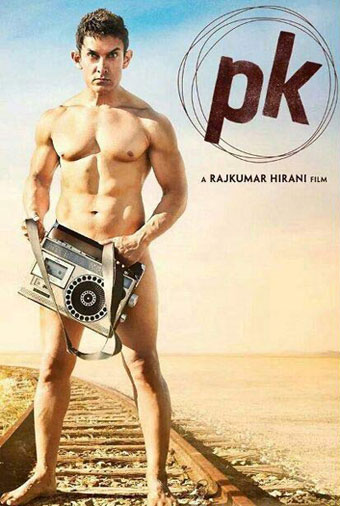Supreme court's artistic strain & media's hypocrisy
By Radheysham Tiwari | PUBLISHED: 18, Aug 2014, 12:23 pm IST | UPDATED: 07, Sep 2014, 17:42 pm IST
 The
The so called branded naked scene on the film poster of Aamir Khan by some of the media houses needed explanations to understand the message. Our country has accepted the portraying of nudity by depicting sex rituals on the walls of the temples all over India and worshipping the image of Shivling religiously every year since time immemorial. In such an intellectually matured country how can nudity be taken so very casually by intellectuals 2013?
In the poster of PK the actor appears to been hiding his private parts behind the a big transistor. So frontal was completely hidden. It was like many of the farm labourers standing in the field with a nude body covering his private part under a little cloth. No one cares to make any fuss and face about the most ancient life style in rural villages .But when it comes to educated and white collared Indians many aesthetic analyists put the pictures upside down and suddenly every simple thing transforms in a debate on social values.
The poster met with same fate of Indian hypocrisy. It is undeniable truth that the world wide electronic media is doing what that big transistor did to that poster of Mr Aamir Khan. Since invention the electronic media is used for covering the truth and the reality in favor of the government or the person who owns it. Had that transistor not been in the hands of the subject of the poster interpretation would have been different and vulgar in legal sense . If there had not been the electronic media, truth of the society would have been strikingly real and depressing.
We have to appreciate the wisdom of supreme court of India which rejected the petition with a artistic comment. We are proud of the Supreme Court of India’s humanistic decision which left it to conscious of the viewers to see or not to see such controversial film while rejecting an appeal by All India Human Right and Social justice Front.
Viewers have the right to choose between art and vulgarity. The apex court maintained that such matters that have been objected by the petitioners are matters of entertainment and art and that should be better left to them as they are. The sublime decision of the highest court reminds of the writings of great saint poet Tulsi Das who once wrote in Ram Charit Manas “ Every one sees his own vision of god while looking at Ram’s image. This particular million dollar observation of the Supreme Court of India exposes the hypocrisy of Indian media which dances and creates cultural values to the tune of the employers. None of the channels which blew the controversy out of proportion could care any less to show the judgment news in brief.
 The so called branded naked scene on the film poster of Aamir Khan by some of the media houses needed explanations to understand the message. Our country has accepted the portraying of nudity by depicting sex rituals on the walls of the temples all over India and worshipping the image of Shivling religiously every year since time immemorial. In such an intellectually matured country how can nudity be taken so very casually by intellectuals 2013?
The so called branded naked scene on the film poster of Aamir Khan by some of the media houses needed explanations to understand the message. Our country has accepted the portraying of nudity by depicting sex rituals on the walls of the temples all over India and worshipping the image of Shivling religiously every year since time immemorial. In such an intellectually matured country how can nudity be taken so very casually by intellectuals 2013? 